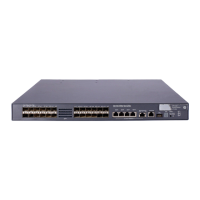183
Configuring one-to-one VLAN mapping
Perform one-to-one VLAN mapping on wiring-closet switches (see Figure 58) to isolate traffic by both user
and traffic type.
Perform these tasks to configure one-to-one VLAN mapping:
Task Description
Configuring an uplink policy Creates CVLAN-to-SVLAN mappings (required).
Configuring a downlink policy Creates SVLAN-to-CVLAN mappings (required).
Configuring the customer-side port
Configures settings required for one-to-one VLAN mapping
(required).
Configuring the network-side port
Configures VLAN settings required for normal communication
(required).
Configuration prerequisites
Create CVLANs and SVLANs, and plan CVLAN-SVLAN mappings.
Configuring an uplink policy
To configure an uplink policy to map each CVLAN to a unique SVLAN:
To do... Use the command... Remarks
1. Enter system view
system-view —
2. Create a class and enter class
view
traffic classifier tcl-name
[ operator { and | or } ]
3. Specify a CVLAN as the
match criterion
if-match customer-vlan-id vlan-id
4. Return to system view
quit
Required.
Repeat these steps to configure
one class for each CVLAN.
5. Create a traffic behavior and
enter traffic behavior view
traffic behavior behavior-name
6. Configure an SVLAN marking
action
remark service-vlan-id vlan-id
7. Return to system view
quit
Required.
Repeat these steps to configure
one behavior for each SVLAN.
8. Create a QoS policy and
enter QoS policy view
qos policy policy-name Required.
9. Associate the class with the
behavior to map the CVLAN
to the SVLAN
classifier tcl-name behavior
behavior-name
Required.
Repeat these steps to create other
CVLAN-to-SVLAN mappings.
Configuring a downlink policy
To configure a downlink policy to map SVLANs back to CVLANs:
To do... Use the command... Remarks
1. Enter system view
system-view —
2. Create a class and enter class
view
traffic classifier tcl-name
[ operator { and | or } ]
Required.

